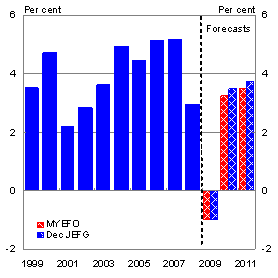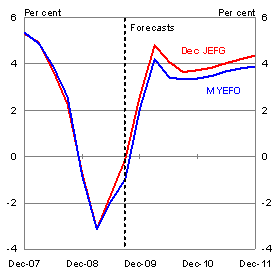Table 1: International GDP growth forecasts(a)

(a) Calculations for World and euro area growth rates use GDP weights based on puchasing power parity (PPP). Calculations for Major Trading Partners and Other East Asia use export trade weights.
(b) Other East Asia is: Korea, Taiwan, Hong Kong, Singapore, Indonesia, Malaysia, Thailand, Vietnam and the Philippines.
Source: National statistical publications, IMF and Treasury.
World outlook
Since MYEFO, the flow of data has provided further confirmation of recovery in the global economy. Apart from the United Kingdom, all of Australia's major trading partners expanded in the September quarter, and confidence and activity continue to recover toward pre-crisis levels. Export-dependent economies have generally experienced the fastest rebound, as the recovery in world trade proceeds.
Consistent with the more positive outlook, financial market conditions have continued to improve. Short-term inter-bank funding spreads have moderated significantly and are approaching pre-crisis levels, and many financial institutions are no longer reliant on government support to obtain funding.
However, conditions remain difficult in some parts of the financial system. Long-term securitisation markets remain stressed and continue to be heavily supported by central banks. Lower-rated long-term bond spreads remain well above pre-crisis levels and some lower-rated financials are still finding it difficult to raise funding without government support. Some pressures remain on financial intermediaries' funding costs, with these higher costs being reflected in lending spreads.
While data have generally been better than expected since MYEFO, uncertainty remains over the strength of the recovery. Growth in the September quarter slowed in most Asian economies and remained tentative amongst Atlantic economies. With hours worked and employment continuing to trend lower in advanced economies, a durable recovery in private demand has yet to be fully established. Continued slack in labour markets is expected to constrain consumption growth over the forecast horizon.
Chart 1: World GDP growth

Source: IMF and Treasury.
On balance, the outlook for world growth has improved. As a result, world GDP growth forecasts have been upgraded by ¼ of a percentage point in both 2010 and 2011 (Chart 1). Collective major trading partner (MTP) growth has been revised up by ½ of a percentage point in both 2009 and 2010 and by ¼ of a percentage point in 2011 (Chart 2).
Chart 2: Through-the-year MTP growth

Source: National agencies and Treasury.
Most individual trading partner forecasts have been revised higher, particularly in Asia (Table 1). Stronger-than-expected data have seen growth forecasts upgraded in emerging Asia, led by India, while advanced Asia has also been revised higher as recovery takes hold amongst the hard-hit and trade-exposed Newly Industrialised Economies. Forecasts for China, where events have unfolded as expected, are unchanged. Forecasts for the US, UK and euro area have been upgraded, particularly in 2010, although growth in these economies is expected to remain below trend across the forecast horizon.
Risks
A high level risk confronting the global economy is an outbreak of protectionism, which the world has largely avoided thus far. In particular, below-trend growth and persistently high unemployment in the US, combined with concerns that China is relying excessively on an undervalued exchange rate and the external sector for its growth, could fuel protectionist pressures.
While financial market conditions are normalising, risks have not disappeared. The recent debt moratorium in Dubai and heightened concerns about the sustainability of Greece's fiscal position have highlighted risks around the ability of some countries to manage high levels of debt.
In addition, concerns about the potential for new asset price bubbles in emerging markets are increasing. Driven by their solid growth prospects, and low borrowing costs in key advanced economies, many emerging economies have seen increasing capital inflows which have placed upward pressure on their currencies.
Country summaries
The outlook for the United States has continued to improve, with widespread signs of a policy-supported recovery in the September quarter raising near-term expectations. Stronger household consumption and further improvements in housing market conditions should support growth in coming quarters, augmenting the large boost provided by a turn in the inventory cycle and the fiscal stimulus package. Accordingly, 2 per cent growth is forecast for 2010 and 2011, a ½ and ¼ of a percentage point upgrade respectively.
Nevertheless, the recovery is still expected to be tepid compared to past recessions, with growth forecast to remain below trend in both 2010 and 2011. Recent increases in activity have been heavily influenced by policy, with scant signs of the broad-based improvement in private final demand which will be necessary to support a return to strong growth once the impacts of stimulus and inventory adjustment fade.
Our baseline expectation is for US consumption growth to be highly restrained over the forecast horizon. However, it is possible that spending could rebound more strongly should US households engage in more modest deleveraging than envisaged, particularly if asset values continue to rebound and the labour market recovery is less protracted than anticipated.
The outlook for China is unchanged since MYEFO. Since the implementation of the fiscal stimulus package a year ago, the Chinese economy has recovered strongly from record low growth through the year to the March quarter 2009. With support from stimulus expected to continue into 2010, China is forecast to grow by 8¼ per cent in 2009, accelerating to 9¼ per cent in 2010, before stabilising at 9½ per cent, around trend, in 2011.
Domestic demand continues to benefit considerably from Government policies, with stimulus-affected consumption and production sectors experiencing particularly strong growth. While investment is expected to be the main driver of growth in 2010, consumption is expected to remain solid, buttressed by continued policy and subsidy support. The external sector is also expected to benefit in the short run from stimulatory policies and the recent effective depreciation of the Renmimbi.
The sustainability of growth once stimulus winds down in late 2010 will hinge upon a recovery in private and global demand. The re-emergence of inflationary pressures, potential asset price bubbles, an increase in non-performing loans, and overcapacity in the steel sector, present additional downside risks. However, recent statements suggest that the Government recognises these risks and is prepared to act if necessary.
The Japanese economy is facing a fragile recovery. On the one hand, growth is expected to be boosted by a continued rebound in exports and industrial production, particularly driven by demand from emerging markets. In addition, sizeable fiscal stimulus, which is anticipated to be carried through into 2013, will provide support to consumption. On the other hand, the waning effect of inventory restocking will
weigh on production, while continued yen strength will act as a drag on export growth. Business investment is likely to remain relatively subdued, given the sizeable output gap, tight financial conditions and prolonged deflationary pressures. In addition, a full-fledged recovery in consumption is unlikely as long as employment and incomes remain weak.
Japan is forecast to contract by 5¼ per cent in 2009, before returning to above-trend growth of 1¼ per cent in 2010 and 1¾ per cent in 2011. A sustained recovery in the corporate sector and its flow-on effect on households will be key determinants of the outlook for Japan.
The Newly Industrialised Economies continue to recover at a solid pace. GDP in the NIEs is forecast to contract by 1¼ per cent in 2009, before recovering to grow by 5 per cent in 2010 and 4¼ in 2011. Growth momentum is expected to pick up mainly due to improvements in domestic demand. Stronger growth prospects have seen large capital inflows into the NIEs from mid-2009. However, this has raised concerns about asset bubbles, which may induce policymakers to raise interest rates and adopt measures to maintain export competitiveness and limit financial instability.
The outlook for the Indian economy has improved considerably since MYEFO. The recovery, which began in the early part of 2009, is expected to continue on the back of improved business and urban consumer confidence, and an improved outlook for key export economies. Renewed foreign capital inflows — a driver of investment growth prior to the financial crisis — are also expected to support growth. Accordingly, forecasts for 2009, 2010 and 2011 have been revised up to 6¾ per cent, 7¼ per cent and 7 per cent.
Direct impacts from India's worst drought since 1972 are expected to be modest, as agriculture accounts for a relatively small share of GDP. Nevertheless, consequent food scarcity will keep inflationary pressures elevated, and together with the strengthening recovery, will likely prompt a tightening in monetary policy in early 2010.
Economic activity in the ASEAN-5 region has continued to show encouraging signs of consolidation, as improved consumption led to positive September quarter GDP outturns across the region. The region is forecast to grow by ¼ per cent in 2009, before rebounding to 4¾ per cent in 2010 and 2011.
Downside risks to the ASEAN-5 outlook remain, including potential bottlenecks in fiscal stimulus spending across the region and a weak external position in Vietnam. On the upside, stronger US household consumption and better growth prospects in the major economies may help to lift growth. Improved capital flows into the region will also help boost liquidity and investment. However, the rise in capital inflows may also slow exports as currencies appreciate, and stoke inflation and asset price bubbles.
The improved euro area economic outlook reflects strengthening sentiment in most sectors, an increase in new export orders, and the continuation of fiscal support measures. Inventory restocking is also expected to provide temporary support to growth in the short term. However, the recovery is expected to remain sluggish as labour market deterioration continues and the appreciation of the euro weighs on export growth. As such, GDP is forecast to contract by 4 per cent in 2009, a ¼ of a percentage point upgrade, with growth of 1 per cent and 1¼ per cent forecast for 2010 and 2011.
Recent indicators suggest the United Kingdom economy is improving, with the recession expected to end in the December quarter 2009. Nonetheless, the recovery is expected to remain weak and prolonged, as growth is held back by constrained access to credit. High levels of public and private debt, along with the need to unwind large policy stimulus will also weigh on the recovery. GDP is forecast to contract by 4¾ per cent in 2009, before recording modest growth of 1 per cent in 2010 and 2 per cent in 2011.
New Zealand's recovery from prolonged recession has been quicker than expected, with the outlook improving markedly, aided by strong external demand from China. Forecasts for growth have been upgraded in all years, particularly in 2010, with GDP projected to grow by 2¼ per cent in 2010 and 2¾ per cent in 2011. While the outlook has improved, there is a risk that further appreciation of the dollar may weigh on growth.